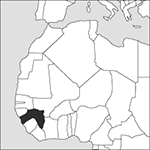
Source: MAPS IN MINUTES™ © RH Publications (1997)
Capital:
Conakry
Area:
245,857 sq km (94,926 sq miles)
Population:
11,176,026 (2013 est)
Currency:
1 Guinean franc = 100 centimes
Religions:
Muslim 85.0%; Christian 8.0%; traditional beliefs 7.0%
Ethnic Groups:
Peuhl 40.0%; Malinke 30.0%; Soussou 20.0%
Languages:
French (official); local languages
International Organizations:
UN; AU; ECOWAS; Non-Aligned Movement; WTO
A West African country with an Atlantic coast, bounded on the north by Senegal, Guinea-Bissau, and Mali, on the east by Côte d’Ivoire, and on the south by Liberia and Sierra Leone.
Physical
Inland from the marshy coast is a plain with large bauxite deposits. This rises to a sandstone plateau, the Fouta Djallon. Southward is the source of the Niger River; and further south still (the country bends like a hook) are large reserves of iron ore.
Economy
Guinea is richly endowed with natural resources, and the major exports are bauxite, alumina, gold, and diamonds. Iron-ore mining is being developed. However, it is a poor country with over 75% of the population working in agriculture. Principal crops are rice, coffee (which is exported), pineapples, palm kernels, and cassava.
History
From the 5th to the 8th centuries ad, the far north of modern Guinea formed part of the kingdom of Ghana. This area of the country was incorporated in the Mali Empire in the 16th century. From 1849 onwards, French encroachment upon the region increased, leading to conflict with the empire of Samori Touré in eastern Guinea c.1879–91, when Guinea became a French colony. In 1895 Guinea was made part of the huge territory of French West Africa, and remained a French colony until 1958, when a popular vote rejected membership of the French Community, and Ahmed Sékou Touré became first President. His presidency was characterized by severe unrest and repression, and almost complete isolation from the outside world, although before his death in 1984 a degree of liberalization was introduced. This trend has continued under the military rule of President Lansana Conté. In 1990 Conté established a Transitional Committee for National Recovery, following a referendum that backed a new constitution. The slow pace of democratization, together with an IMF-imposed austerity programme, led to a general strike in 1991, after which the government introduced a multiparty system. In 1993, in the country’s first multiparty elections, Conté was re-elected. He retained power until his death (2008), which was immediately followed by a military coup. Elections were not held until 2010, when Alpha Condé, an opposition politician, was elected President; he was re-elected in October 2015. The first cases of Ebola fever in West Africa are thought to have occurred in south-eastern Guinea in late 2013, but none were formally diagnosed until March 2014. The worst of the outbreak was over in 2015, but a few cases continued into 2016. By April 2016 2,544 deaths had been recorded by the World Health Organization. The outbreak crippled Guinea’s economy and highlighted the inadequacies of its health system
- petroleum reservoir
- petrological microscope
- petrology
- petrophysics
- Dinomastigota
- Dinophyceae
- Dinophysiales
- dinosaur
- dinosaurs
- dinucleotide
- Diocletian (245–313)
- diode
- diode detector
- diode drop
- diode forward voltage
- diode laser
- diode transistor logic
- diode-transistor logic
- diode voltage
- Diodorus Cronus
- dioecious
- Diogenes (400–c.325)
- Diogenes Laertius (3rd)
- Diogenes of Apollonia (5th)
- Diogenes of Sinope (c.400–325)